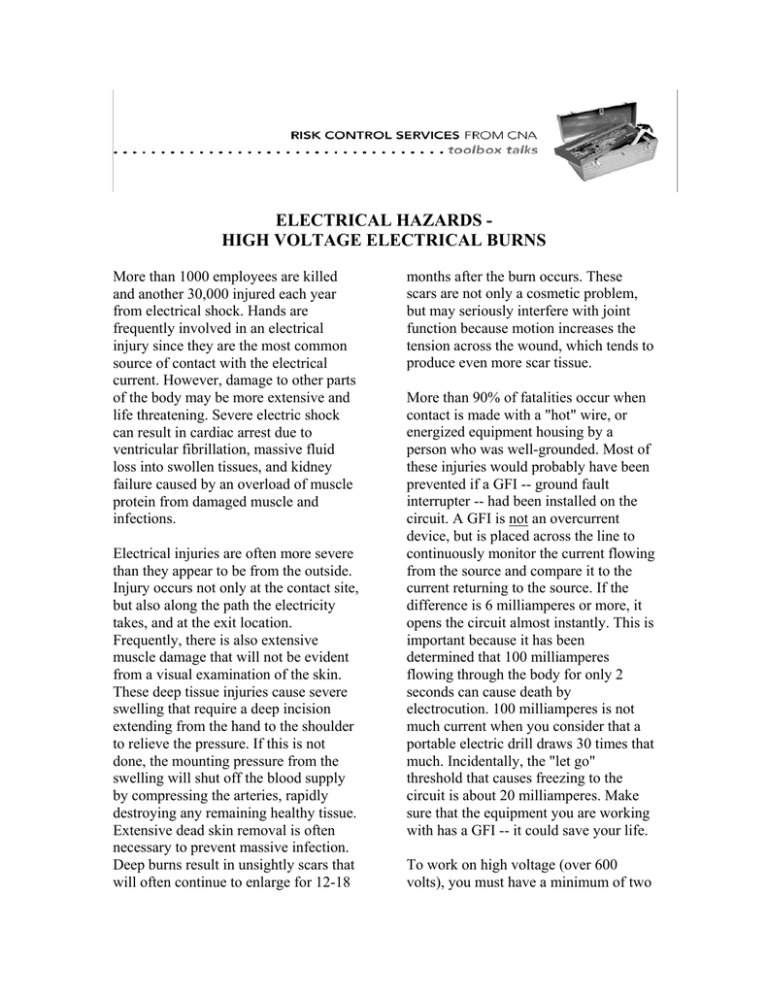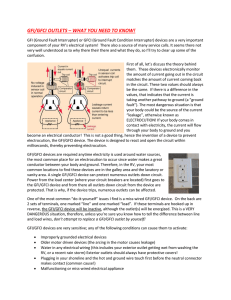ELECTRICAL HAZARDS - HIGH VOLTAGE ELECTRICAL BURNS
advertisement

ELECTRICAL HAZARDS HIGH VOLTAGE ELECTRICAL BURNS More than 1000 employees are killed and another 30,000 injured each year from electrical shock. Hands are frequently involved in an electrical injury since they are the most common source of contact with the electrical current. However, damage to other parts of the body may be more extensive and life threatening. Severe electric shock can result in cardiac arrest due to ventricular fibrillation, massive fluid loss into swollen tissues, and kidney failure caused by an overload of muscle protein from damaged muscle and infections. Electrical injuries are often more severe than they appear to be from the outside. Injury occurs not only at the contact site, but also along the path the electricity takes, and at the exit location. Frequently, there is also extensive muscle damage that will not be evident from a visual examination of the skin. These deep tissue injuries cause severe swelling that require a deep incision extending from the hand to the shoulder to relieve the pressure. If this is not done, the mounting pressure from the swelling will shut off the blood supply by compressing the arteries, rapidly destroying any remaining healthy tissue. Extensive dead skin removal is often necessary to prevent massive infection. Deep burns result in unsightly scars that will often continue to enlarge for 12-18 months after the burn occurs. These scars are not only a cosmetic problem, but may seriously interfere with joint function because motion increases the tension across the wound, which tends to produce even more scar tissue. More than 90% of fatalities occur when contact is made with a "hot" wire, or energized equipment housing by a person who was well-grounded. Most of these injuries would probably have been prevented if a GFI -- ground fault interrupter -- had been installed on the circuit. A GFI is not an overcurrent device, but is placed across the line to continuously monitor the current flowing from the source and compare it to the current returning to the source. If the difference is 6 milliamperes or more, it opens the circuit almost instantly. This is important because it has been determined that 100 milliamperes flowing through the body for only 2 seconds can cause death by electrocution. 100 milliamperes is not much current when you consider that a portable electric drill draws 30 times that much. Incidentally, the "let go" threshold that causes freezing to the circuit is about 20 milliamperes. Make sure that the equipment you are working with has a GFI -- it could save your life. To work on high voltage (over 600 volts), you must have a minimum of two years of training, experience with high voltage circuits, have demonstrated that you are familiar with the work to be performed, and the hazards involved with high voltage work according to OSHA. Other safety requirements that must be followed include using insulated gloves for current over 300 volts, eye Date: Company Name: Project Number/Name: Meeting Location: protection, and lockout/tagout if working on energized parts of equipment or systems. Conductive measuring tapes, ropes, or similar devices obviously cannot be used around exposed conductors, and conductive fish tapes cannot be used if they will be entering enclosures with exposed conductors. Person Conducting Meeting: Items Discussed: ______________________________________________________________________________ _____________________________________________________________________________________________ Problem Areas or Concerns: ___________________________________________________________________ _____________________________________________________________________________________________ Attendees: ___________________________________________________________________________________ _____________________________________________________________________________________________ Comments: __________________________________________________________________________________ _____________________________________________________________________________________________











